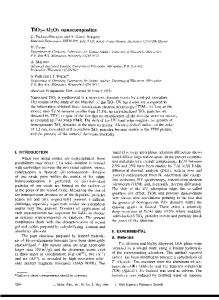Thermal Characterization of Nanowire Array in a -Al 2 O 3 Matrix
- PDF / 192,448 Bytes
- 6 Pages / 612 x 792 pts (letter) Page_size
- 43 Downloads / 251 Views
Thermal Characterization of Nanowire Array in a-Al2O3 Matrix Diana-Andra Borca-Tasciuc1†, Gang Chen1, Yu-Ming Lin2, Oded Rabin2, Mildred S. Dresselhaus2,3, Alexander Borshchevsky4, Jean-Pierre Fleurial4, and Margaret A. Ryan4, 1 Mechanical Engineering Department, Massachusetts Institute of Technology, Cambridge, MA 02139, USA 2 Physics Department, Massachusetts Institute of Technology, Cambridge, MA 02139, USA 3 Electrical Engineering Department, Massachusetts Institute of Technology, Cambridge, MA 02139, USA 4 Jet Propulsion Laboratory/California Institute of Technology, 4800 Oak Grove Drive, MS 277-207, Pasadena, CA 91109, USA ABSTRACT Thermal properties characterization of Bi nanowires is critical in order to validate the predicted enhancement of their thermoelectric figure-of-merit. In this paper we report the effective thermal diffusivity of Bi nanowires array embedded in a-Al2O3 (alumina) template. The composite material consists of 85% alumina and approximately 15% Bi nanowires with a diameter of 40 nm and an average length of 40 µm. Measurements are performed along the nanowire axis. A thermal wave is produced at the front side of the sample and it is monitored at the backside through a fast thermoelectric effect. A one-dimensional heat conduction model is used to extract the thermal diffusivity. INTRODUCTION The efficiency of a thermoelectric device is limited by the thermoelectric figure-of-merit of the material Z =σS2/k, where S is the Seebeck coefficient, σ is electrical conductivity, and k is the thermal conductivity. Currently, the best commercially available thermoelectric material (BiSb)2Te3 has a ZT of ~1, however thermoelectric devices based on this material cannot compete in performance with other well-established technologies. Several approaches have been explored to increase the thermoelectric figure-of-merit [1,2]. Among those, low-dimensional thermoelectric materials structures such as quantum wells, superlattices and nanowires have been extensively investigated [3-7]. As predicted by Hicks and Dresselhaus [2,8], quantum effects in low-dimensional systems may result in increased density of states near Fermi level and consequently increased electrical conductivity and Seebeck coefficient. Furthermore, increased scattering of heat carriers from interfaces leads to a decreased thermal conductivity in such systems. In light of these, theoretical studies done on bismuth nanowires estimate a significantly enhanced thermoelectric figure-of-merit [5]. However, experimental measurements must be carried out in order to validate the theoretical estimations. While electrical properties and Seebeck coefficient of bismuth nanowires have been characterized [9], another key property of a material candidate to thermoelectric applications, thermal conductivity, has yet to be determined experimentally. However, manipulation and preparation of test specimens of nanometer size is not an easy task. Therefore, a first approach in
†
Visiting student from UCLA.
V2.7.1
exploring thermal properties of nanowires is











